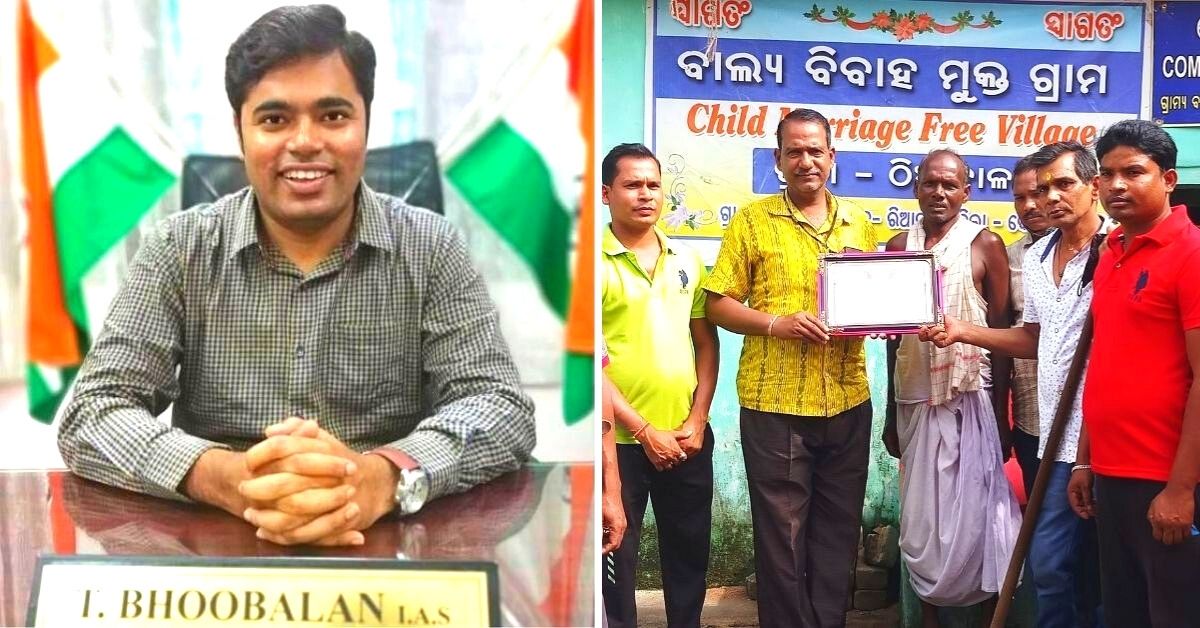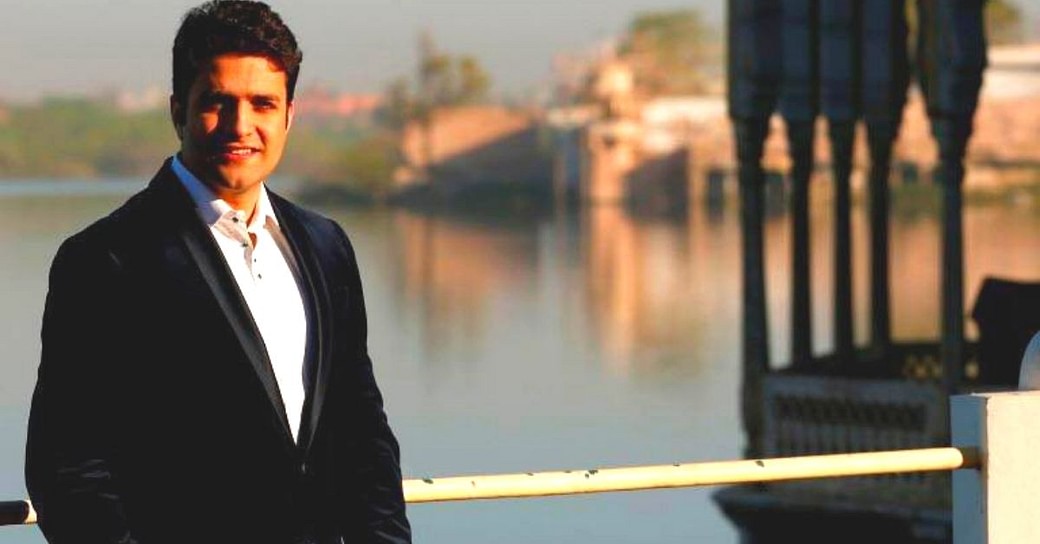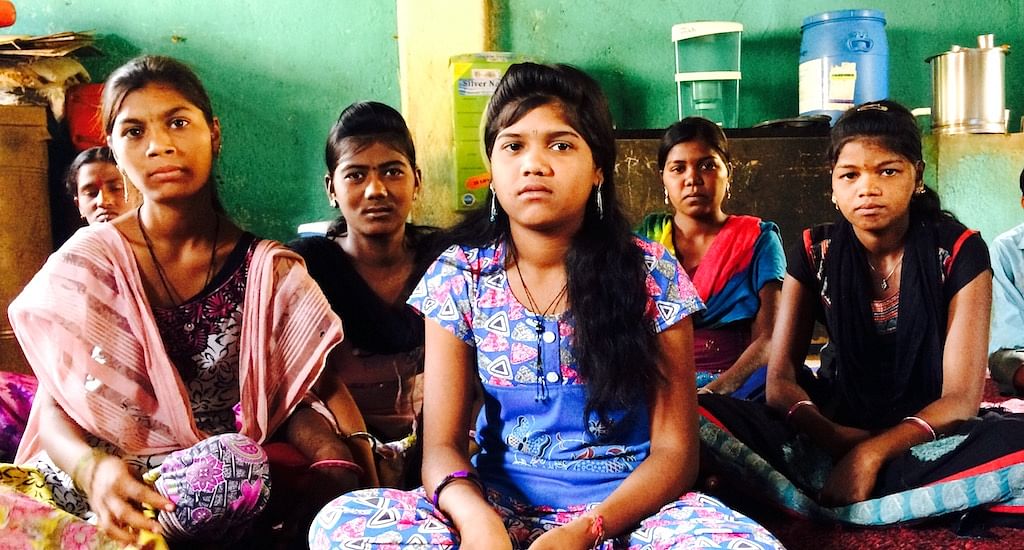Raising Marriage Age Isn’t Enough: IAS Officers, Civic Heroes Show What Needs to Be Done
The Union Cabinet has introduced a bill to raise the minimum age of marriage for women from 18 to 21 years. Here are four initiatives by IAS officers, local communities and civil society that show us how this can be done better.

A recent development that has sparked much debate is the Union Cabinet’s decision to clear a proposal raising the minimum age of marriage for women from 18 to 21 years.
(Image above of IAS officer T Bhoobalan on the left and Thianal village on the right)
Prima facie, this decision feels like a step in the right direction, but experts have deemed that it only addresses the symptoms rather than the underlying causes of why young girls and women are married off at such an early age. They argue that there are a host of factors that contribute to the incidence of early and forced marriages from deep-rooted gender equality, financial insecurity, regressive social norms to lack of quality education and employment opportunities.
In a recent statement issued by the Population Foundation of India, a non-profit, they said:
Increasing the legal age at marriage without a shift in communities’ perceptions around the practice can have several negative consequences. Increasing the legal age will mean a large number of married persons will be deemed underage, thereby putting a question mark around the legality of their marriages. Despite laws mandating minimum age and criminalising sexual intercourse with a minor, child marriages are very prevalent in the country, with almost one-fourth of women (aged 20-24 years) being married before the legal age of 18, according to the fifth National Family Health Survey (2019-21). In most cases, girls who get married early do not have the agency to move the Court and ask for the marriage to be rendered void despite ill-treatment. Increasing the legal age at marriage would perhaps accomplish little more than pushing more marriages underground as has been the practice in the past.
Instead of raising the minimum age, a better approach to reduce the incidence of early marriage is stricter enforcement of existing laws, investing in the education of girls, empowering women economically and socially and targeted social and behaviour change within communities that encourage these practices.
Here are four initiatives covered by The Better India, which show how members of the civil services and civil society successfully addressed this issue.
1) T Bhoobalan, Zila Parishad CEO in Karnataka’s Bagalkot district (2020-21)
Sometime in July 2020, as COVID-19 was raging in his district, the Zila Parishad CEO, T Bhoobalan, began receiving a disturbing number of calls reporting child marriages. The lockdown, subsequent loss of livelihoods and the ensuing poverty had seen many families give up their girls below the age of 18 to marriage because they couldn’t afford to feed them.
Although child marriage was a problem that predated the pandemic, it exacerbated the problem. Spending around a month, he soon understood that child marriage was closely interlinked with issues of malnutrition, school dropouts, anaemia and eventually maternal mortality. To address the rampant practice of child marriage, in July 2020, he devise a multi-pronged approach, and alongside a team consisting of members of the gram panchayats, Anganwadi workers, police officers, school teachers and revenue officers, prevented more than 170 child marriages.
Besides filing FIRs against some parents, he also did the hard work of raising awareness and educating the people about The Prohibition of Child Marriage Act, 2006, alongside a committee of local government officials and school teachers, while also forming committees at the gram sabha level to do the same and educate people about the dangers of child marriage.
This committee also encouraged more reporting of child marriages by guaranteeing complainants that their names will be kept anonymous. After all, many child brides fear reprisal from parents or other family members if they file a complaint with the authorities. Complainants could either call the 1098 helpline or contact their designated local official directly, and if none of these avenues worked out, Bhoobalan offered his mobile number as well.
Another issue was many young people having to migrate back to the villages due to lack of work. They were being forced to marry. They were given jobs through MGNREGA.
Once rescued from child marriage, the girl/boy were sent before a Child Welfare Committee for counselling, and depending on a variety of factors, sent back home or kept under the custody of a child welfare home. Although the priority is to send a child home to prevent the least disruption of their life and education, there are instances when the child suffers from abuse and harassment.
Therefore, they are kept at a child welfare home. More importantly, the process of rehabilitation, particularly for young girls, involves engaging them in skill development programmes like dairy and poultry farming, tailoring, embroidery, and also computer science. In fact, when the girl turns 18, she is employed as a data operator in the administration’s office. Meanwhile, for a few girls, the administration has helped sponsor their high school education.
For those sent home, the administration also runs an online portal called ‘Surakshini’ which keeps track of the child’s status, and all concerned department officials must log into it regularly. Aiding this process is regular weekly visits to the child’s home.
2) Athar Aamir Khan, SDM of Bhilwara District, Rajasthan (2018-19)
As a sub-divisional magistrate in Bhilwara district, Athar Aamir Khan adopted a two-fold method to enforce the law against rising cases of child marriage in the district.
On the one hand, he appointed local informers to raise alarms against cases of child marriage, while keeping the police in the loop to enforce the law. All this was coordinated through a special control room, which was set up to exclusively address cases of child marriages. On the ground, enforcement was organised through a flying squad consisting of local station house officers (SHOs), tehsildars, panchayat committee members and other government employees.
Besides strict enforcement, however, Khan also organised a massive awareness campaign at a community level, alongside local Anganwadi workers, self-help groups and rural Gram Vikas committees, who were also trained extensively on preventing this practice. Following their training, they would hold regular public meetings with villagers across the gram sabhas that fell under Khan’s jurisdiction. They would also accompany Khan to other sites like schools, social gatherings and community halls to raise awareness against the evils of this practice.
In schools, teachers were directed to create safe spaces for minor girls who could be forced into marriage, allowing them to report cases without any hassles. Children in schools were asked to participate in a quiz about the Child Marriage Act, 2006, which not only informed them about their rights but also educate them on what would happen to their parents and family members if they violated the law. Khan’s emphasis on education was a game-changer.
To ensure children stayed in schools, he took the effort of rebuilding the dilapidated infrastructure of government schools under his jurisdiction working closely alongside villagers, encouraging them to donate as well in any capacity. Once he transformed the dilapidated structures into ‘model schools’, influential persons from the region were invited to visit them.
What stands out about the process is the degree of community engagement showing village heads, teachers, parents and other stakeholders the fruits of their labour, time and money in transforming 70-odd schools in the area. Some of the village heads had even adopted the schools. Taking things further, for secondary school students, Khan started a counselling cell, which would give them study materials and insight into different career options.
“There is less opposition and resistance when people are on your side. Only a little push was needed to make them realise the effects of practices like child marriage and the importance of education. We still have a long way to go in bringing about a real change, but the fact that it has started is motivating enough for me to continue this movement,” Khan said.

3) Documentation in Thianal Village, Odisha (2021) & Civil Society Action in Shivali village, Maharashtra (2017)
At the entrance of Thianal village in Deogarh district, Odisha, there is a primary school and its wall is a poster that highlights its status as the ‘First Child Marriage Free Village’ of the district. According to this report (TBI link), what played a pivotal role in addressing the evil of child marriage is simple documentation and community-level awareness. No marriage in the village is solemnised without proper verification of documents like Aadhar card verification.
“Most people in our villages didn’t know that there was a legal age in marriage. Almost all marriages in our parent’s generation happened when both the bride and groom were minors. Though the cases dropped after some years, early marriage was still common as there was no means of verification. So, now we have made Aadhar card verification mandatory before finalising any marriage,” said Ajit Pradhan (32), a resident of the village, who was among the first ones to take this initiative. If the family cannot furnish Aadhar cards, the village accepts other government-mandated documents for age proof.
In February 2020, a village-level task force was set up consisting largely of village elders, which then prepared a database of all adolescents. No marriage is allowed in a village without a comprehensive age verification of the bride and groom by this village committee.
If a marriage has been organised between a member of this village and a member of another, the committee has access to a directory created by the State government with contact numbers of members from other village committees. “If a boy of our village is getting married to a girl in Kantapalli panchayat in our district, we directly dial the Sarpanch or Anganwadi or Asha worker and ask them to ascertain the girl’s age through document verification,” added Ajit.
The village also has a ‘Counselling room,’ where ASHA and Anganwadi workers hold regular sessions on adolescent-related issues. But then again this isn’t enough as most girls end up quitting their studies once they turn 18 and are married. This is but one step in the process.
Taking things further is Aroehan, a non-profit based out of Mokhada taluka in Palghar district, Maharashtra, which convinced 175 families of Shivali village to not just stop child marriages through various community engagement measures, but also pursue further education and vocational training. Shivali is home to members of the Warli scheduled tribe, where the once long-held tradition was to marry off girls once they reach the age of 15.

Besides passing a resolution against early marriage in 2014, which in itself wasn’t an easy task, the non-profit also worked with the local community to encourage young girls in the village to finish high school and learn vocational skills like tailoring and nursing.
(Edited by Yoshita Rao)
Like this story? Or have something to share? Write to us: [email protected], or connect with us on Facebook and Twitter.
If you found our stories insightful, informative, or even just enjoyable, we invite you to consider making a voluntary payment to support the work we do at The Better India. Your contribution helps us continue producing quality content that educates, inspires, and drives positive change.
Choose one of the payment options below for your contribution-
By paying for the stories you value, you directly contribute to sustaining our efforts focused on making a difference in the world. Together, let’s ensure that impactful stories continue to be told and shared, enriching lives and communities alike.
Thank you for your support. Here are some frequently asked questions you might find helpful to know why you are contributing?


This story made me
-
97
-
121
-
89
-
167











